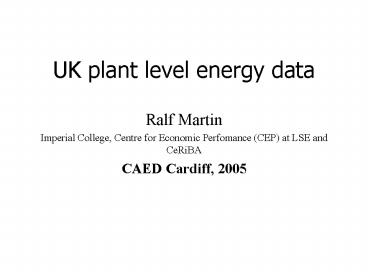UK plant level energy data - PowerPoint PPT Presentation
1 / 28
Title:
UK plant level energy data
Description:
... level data on energy demand and prices within UK ARD/ONS microdata research lab ... The problem with entry and exit in the QFI/ARD sample. Merging QFI and ARD ... – PowerPoint PPT presentation
Number of Views:27
Avg rating:3.0/5.0
Title: UK plant level energy data
1
UK plant level energy data
- Ralf Martin
- Imperial College, Centre for Economic Perfomance
(CEP) at LSE and CeRiBA - CAED Cardiff, 2005
2
What this presentation is about
- Discuss newly available plant level data on
energy demand and prices within UK ARD/ONS
microdata research lab - Present initial research results using this data
- Discuss most promising avenues for further
research
3
- Discuss newly available plant level data on
energy demand and prices - Present initial research results using this data
- Discuss most promising avenues for further
research
4
Plant level data on energy
- The ONS Micro Data Research Lab An important
new source for research on business activity
(http//www.statistics.gov.uk/about/bdl/) - So far focus on economic productivity
- Quarterly Fuels Inquiry Data on expenditure and
quantity of various fuel types - Allows to develop various energy related research
routes with plant level data.
5
What the QFI surveys
6
Observations in QFI
7
QFI firms across sectors (2000)
8
The problem with entry and exit in the QFI/ARD
sample
9
Merging QFI and ARD
Share of observations merged across years
10
- Discuss newly available plant level data on
energy demand and prices - Present initial research results using this data
- Discuss most promising avenues for further
research
11
In which policy/research areas could this data be
useful?
- 2 spheres of interest
- Environmental Economics/Policy
- how to reduce energy consumption and improve
efficiency? - Industrial Economics/Policy
- functioning of energy markets
- predicting energy demand
12
Microdata results so far
- On environmental issues
- Energy efficiency spread calculations
- Correlations between energy efficiency and labour
productivity - Energy efficiency transition matrices
- CO2 reduction potential
- Sensitivity of energy efficiency on energy price
- Energy efficiency growth decompositions
- On industrial policy
- Fuel price dispersion
- Explaining electricity price dispersion (a bit)
- Some results on NETA
13
Energy efficiency spreads
- .an indication of potential efficiency gains?
- Not necessarily
- different plants do different things
- face different prices
- substitute between energy and other factors
- have sunk costs
- Only short term shocks
- Nevertheless have look at spreads
14
Results on spreads
- Y/E spreads are larger than Y/L (roughly twice as
larger) - Plausible because labour share in revenue 30,
energy share 2
15
- Persistence of the spread?
- Good spread? No persistence?
- Bad spread? Lots of persistence?
16
Y/L vs Y/E more evidence on what drives the
spread
Suggests that part of energy efficiency
differences are driven by technology rather than
substituion with labour
17
So we have a persistent spread probably driven by
technology.lets take the efficiency improvement
potential idea serious
Y/E
Median
- Examine the potential CO2 reduction if all plants
were at median energy efficiency level
- Combines information on size of the spread and
size of plants at the bottom of the spread
- Caveats
- Not clear how that median is a realistic estimate
of the efficiency frontier - Not clear what the costs are (especially we have
not controlled for capital)
18
CO2 Reduction potential Results (1000s of tons
of CO2)
About 15 of pollution from industry in 2000
19
Fuel price dispersion
- There is dispersion
- No dramatic changes over time
20
Electricity price dispersion across sectors
21
What explains electricity price dispersion?
22
Summary of results
- Energy efficiency spreads are larger than labour
prod spreads - Spreads are persistent
- Strong correlation between energy efficiency and
labour productivity - Possibly Large pollution reduction potential
- Energy Efficiency is sensitive to energy price
- Price dispersion large but fairly constant across
time and sectors - Much of price variation can be explained by
quantity. Still there are significant regional
price variations
23
- Discuss newly available plant level data on
energy demand and prices - Present initial research results using this data
- Discuss most promising avenues for further
research
Thank you
24
Extra slides
25
Extra slide Decomposition calculations
26
How to influence energy efficiency?
27
Extra slide on electricity price dispersion and
NETA
Figure 6 Electricity prices over time (Did the
abolishment of the pool lead to changes?)
28
Energy Efficiency Spreads
- An indication for potential efficiency gains?
3 reasons for energy efficiency differences
1. Differences in factor costs (point 2)
2. Differences in technologies (point 3)
3. Substitution between energy and other factors
(point 4)
Different types might require different policies































